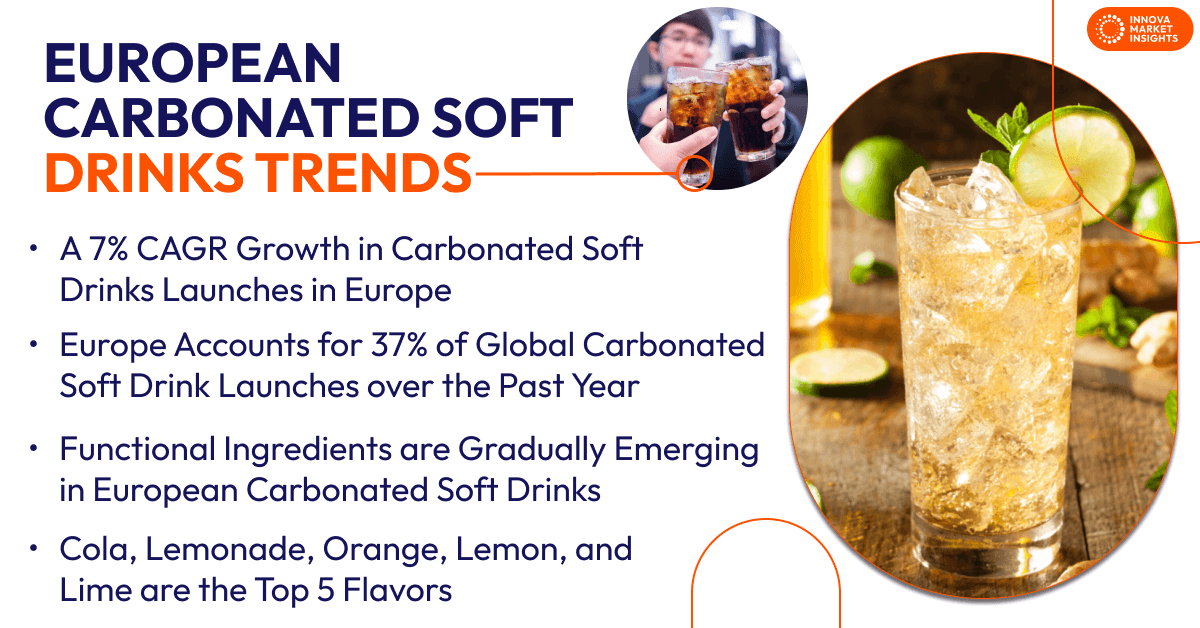October 31, 2024 – In Europe, carbonated soft drinks are preferred for their refreshing taste, diverse flavors, and the sense of indulgence they provide in everyday moments. Innova’s 360 research into carbonated soft drinks trends highlights consumer preferences, market insights, innovations, and what is likely to develop in the future.
Carbonated Soft Drink Market Size and Trends
Carbonated soft drinks are the second subcategory in the soft drinks category, contributing over one-third of European soft drink sales. However, over the past five years, value and volume sales in the European carbonated soft drinks market have generally remained flat.
Germany leads in carbonated soft drinks sales in Europe, followed by Spain and the UK. Spain and Germany have the highest per capita consumption of global carbonated soft drinks, after Canada.
Companies and Brands in The Carbonated Soft Drinks Market
The carbonated soft drinks market is penetrated by both branded and private label companies. In Europe, Coca-Cola leads in carbonated soft drinks market value and volume over the past year.
Coca-Cola is the global innovation leader in carbonated soft drinks, driven by its top brands like Fanta, Sprite, Schweppes, and Diet Coke. The company displays 17% of global juice introductions in 2023. Their new product launches in Europe include Coke Zero K Wave limited edition, Coca-Cola Creations Happy Tears Drops of Joy (available only through TikTok), and Fanta Orange Zero, reformulated with bolder graphics.
Other key players in the market include Nestlé, Pepsico, Aldi, Keurig Dr Pepper, Schwarz, Britvic, Royal Unibrew, Fever Tree, and AG Barr. Nestlé and Britvic experienced a 2% increase in their launch shares since 2019. Carbonated soft drinks trends research shows that these top 10 companies account for 2 in 5 new product launches in the past year. This underscores their strong influence in the carbonated soft drinks industry.

Consumer Soft Drink Preferences
In Europe, 62% of consumers have purchased carbonated soft drinks in the past year, with Sweden and Finland showing the highest global penetration. Soft drinks trends show that 14% of consumers have increased the consumption of carbonated soft drinks over the past year. Gen Z consumers have increased carbonated soft drinks consumption more as compared to other generations.
Two-thirds of Europeans drink carbonated soft drinks weekly, after unflavored bottled water. Most consumers opt for these drinks for mid-afternoon snacks than any other time of day, followed by evening. However, younger generations are expanding consumption times beyond these hours.
Carbonated soft drinks trends research displays that health remains a key concern, with sugar content driving consumer choices. They are influenced by low/no/reduced sugar claims when purchasing carbonated soft drinks. This sugar reduction claim matters most to UK carbonated soft drinks consumers, followed by Ireland, the Netherlands, Finland, and Spain. As a result, some European consumers have decreased drinking due to health concerns, particularly related to weight management. Despite this, over half of consumers still prefer cola-flavored carbonated drinks.
Carbonated Soft Drinks Launch Trends
The carbonated soft drinks market in Europe has experienced a 7% CAGR growth in product launches, nearly double the total soft drinks growth. Soft drinks trends display that Europe accounts for 37% of global carbonated soft drink launches over the past year. Western Europe leads in launches, though other regions have grown faster over the past five years. The UK displays a 4% rise in launches, followed by Ireland.
Health-conscious consumers are driving trends, with 51% of Europeans actively limiting sugar intake and seeking healthier options. Sugar-free claims have increased by 15% CAGR, highlighted in 1 in 4 carbonated soft drink launches. Sugar-reduction claims have become mainstream in most regions, including Europe. Additionally, diet-restriction claims, including vegan, vegetarian, and natural, are gaining consumer attention. Non-alcoholic drinks are also blurring category lines, with no alcohol claims appearing on 2% of new products over the past year.
Functional claims like prebiotics and immune health are emerging, catering to the wellness trend. In packaging, 42% of new launches over the past year used aluminum cans. Environmental claims such as carbon labeling and recycled materials have emerged significantly in the market.
Carbonated Soft Drinks Flavor and Ingredients
Cola, lemonade, orange, lemon, and lime are the top 5 flavors in European carbonated soft drinks launches over the past year. Although cola is the top flavor, the fruit flavors category displays a 4% rise in launches during the same period. Cherry and strawberry are growing fruit flavors. Alcohol inspired flavors have also emerged in launches. Mojito appeared most frequently among the alcohol-inspired flavors.
Soft drinks trends display that functional ingredients are gradually appearing in European carbonated soft drinks. Ingredients like CBD, L-theanine, adaptogenic mushrooms, and inulin are being used to support claims around mood enhancement, focus, and gut health, reflecting the growing consumer interest in wellness.
What’s Next in Carbonated Soft Drinks Trends?
In Europe, around two-thirds of consumers purchase carbonated soft drinks and consume them at least once a week. Gen Z consumers are increasing their intake. Brands can capitalize on this by creating targeted formulations for different generations and occasions. To boost Gen Z adoption, brands can work on high-energy marketing campaigns that emphasize creating adventure, making memories, and connecting with friends.
Consumers in Europe are drinking less carbonated soft drinks due to health concerns around sugar and other ingredients. Brands can directly address these worries with sugar-free formulations and clear labeling. As sugar use declines, artificial and natural sweeteners are becoming more common. However, brands should carefully evaluate sweeteners, as some raise concerns among consumers. By exploring sweetener combinations and modern technologies, brands can create appealing products that align with consumer preferences.
This article is based on Innova’s Now & Next in Carbonated Soft Drinks in Europe report. This report is available to purchase or with an Innova Reports subscription. Reach out to find out more